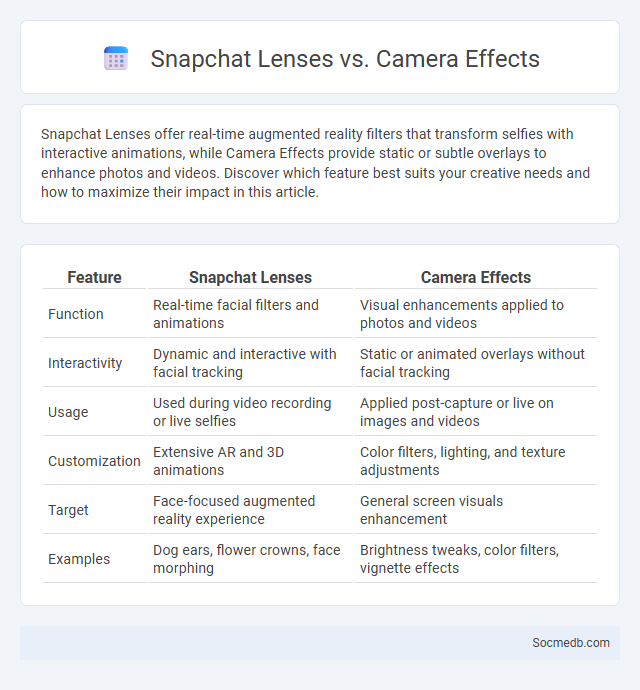
Photo illustration: Snapchat Lenses vs Camera Effects
Snapchat Lenses offer real-time augmented reality filters that transform selfies with interactive animations, while Camera Effects provide static or subtle overlays to enhance photos and videos. Discover which feature best suits your creative needs and how to maximize their impact in this article.
Table of Comparison
| Feature | Snapchat Lenses | Camera Effects |
|---|---|---|
| Function | Real-time facial filters and animations | Visual enhancements applied to photos and videos |
| Interactivity | Dynamic and interactive with facial tracking | Static or animated overlays without facial tracking |
| Usage | Used during video recording or live selfies | Applied post-capture or live on images and videos |
| Customization | Extensive AR and 3D animations | Color filters, lighting, and texture adjustments |
| Target | Face-focused augmented reality experience | General screen visuals enhancement |
| Examples | Dog ears, flower crowns, face morphing | Brightness tweaks, color filters, vignette effects |
Introduction to Snapchat Lenses, Camera Effects, and Lenses
Snapchat Lenses are augmented reality filters that enhance your photos and videos with interactive animations, facial transformations, and 3D effects to create engaging content. Camera Effects on Snapchat utilize real-time computer vision technology to overlay dynamic elements on your surroundings, allowing you to customize your Snaps creatively. You can explore a wide range of Lenses in the Snapchat Lens Carousel or discover new ones through Snap's Lens Studio, which empowers creators to design unique, immersive experiences.
Understanding Snapchat Lenses: Features and Functions
Snapchat lenses utilize augmented reality technology to overlay animated effects and filters on users' faces or surroundings, enhancing real-time photo and video experiences. These lenses include facial recognition, 3D modeling, and interactive elements that respond to user gestures and expressions, providing personalized and dynamic content. Popular for their creativity and engagement, Snapchat lenses also support brand campaigns and promotions through sponsored filters that boost visibility and user interaction.
Camera Effects Explained: Beyond Snapchat
Camera effects on social media platforms extend beyond Snapchat, incorporating augmented reality (AR) filters, 3D animations, and interactive lenses that enhance user engagement. Instagram, TikTok, and Facebook utilize advanced AI-driven effects to enable customizable facial recognition, background transformations, and real-time visual augmentations for immersive content creation. These innovative camera effects increase content virality and brand visibility by driving higher user interaction and creative expression across diverse social networks.
What Are Lenses? Broader Definitions and Usage
Lenses in social media refer to filters or augmented reality effects that modify or enhance images and videos shared on platforms like Snapchat and Instagram. These tools use computer vision technology to apply creative overlays, such as face modifications, virtual objects, or environment changes, enabling users to personalize their content dynamically. Understanding lenses can elevate your social media presence by making posts more engaging and visually appealing.
Key Differences Between Snapchat Lenses and Camera Effects
Snapchat Lenses use augmented reality (AR) to overlay interactive 3D animations and facial recognition features on users' faces in real-time, enhancing selfies and videos. Camera Effects, available on platforms like Facebook and Instagram, primarily apply static or dynamic filters and frames to alter the appearance of photos and videos without real-time facial interaction. While Lenses emphasize immersive AR experiences tied to facial movements, Camera Effects focus on broad visual enhancements and thematic overlays for varied content types.
Comparing User Experience: Snapchat vs Other Platforms
Snapchat offers a unique user experience with its ephemeral content and augmented reality filters, contrasting the more permanent posts and diverse functionalities of platforms like Instagram and Facebook. Snapchat's emphasis on real-time, personal communication creates an immersive environment that appeals to younger demographics seeking authenticity. In comparison, other social media platforms focus on broader content sharing, community building, and algorithm-driven feeds that prioritize engagement over spontaneity.
Customization and Creativity: Which Tool Wins?
Social media platforms offer a variety of customization and creativity tools, but your choice depends on the features that best suit your content goals. Instagram excels with customizable filters and creative editing options, while TikTok provides advanced video effects and sound integration, enhancing engagement through unique storytelling. You can elevate your social media presence by selecting the platform that aligns with your creative style and customization needs.
Accessibility and Platform Compatibility
Social media platforms increasingly prioritize accessibility features such as screen reader support, voice commands, and customizable text size to ensure inclusivity for users with disabilities. Cross-platform compatibility enables seamless user experiences across devices including smartphones, tablets, and desktops, enhancing engagement and reach. Adopting standardized design practices and ARIA (Accessible Rich Internet Applications) guidelines improves usability and compliance with accessibility laws worldwide.
Popular Trends: Snapchat Lenses, Camera Effects, and Lenses
Snapchat Lenses and Camera Effects have revolutionized social media engagement by offering users dynamic, interactive filters that enhance photos and videos in real-time. These popular trends drive higher content creation and sharing, boosting visibility and user interaction on platforms. Using Snapchat Lenses, you can make your social media presence more vibrant and appealing, aligning with the latest digital innovation in visual storytelling.
Conclusion: Choosing the Best for Your Needs
Selecting the best social media platform hinges on understanding your unique goals, target audience, and content style. You should evaluate factors such as user demographics, engagement rates, and platform features to make an informed decision. Tailoring your choice to align with these criteria ensures maximum impact and growth for your online presence.
 socmedb.com
socmedb.com